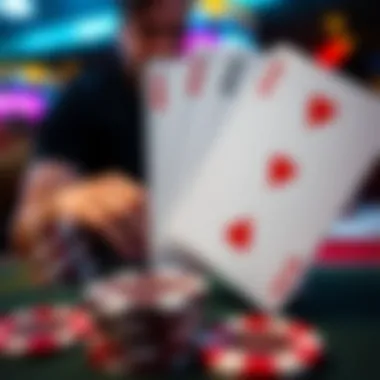Mastering the Strategy of Splitting Aces in Blackjack


Intro
In the colorful world of blackjack, splitting aces is not just a move; it's a strategic art form that can shift the game in your favor. If you've never come across the idea of splitting aces or thought of it just as another mundane rule in the manual, you're in for a treat. Understanding when and why to split aces can elevate your gameplay and bolster overall results at the table. This article aims to steer you through the intricacies of this vital decision, unpacking the mathematics, timing, and common myths that tend to cloud players' judgment.
By diving deep into the mechanics and strategies surrounding splitting aces, you'll emerge with a richer understanding of blackjack as a game. Most importantly, you'll learn how to harness this crucial strategy to your advantage, a move that can mean the difference between victory and defeat. Whether you’re a novice stepping into the vibrant zone of a casino for the first time or an experienced player looking to fine-tune your game, this guide promises to offer you valuable insights into consistently making winning decisions.
So, without further ado, let’s roll into the nitty-gritty with a closer look at the game mechanics and effective strategies.
Game Mechanics and Strategies
Understanding the Rules of Popular Games
In blackjack, the fundamental goal is straightforward: get as close to 21 without going over. However, as any seasoned player knows, the devil is in the details. A basic rule of thumb is to recognize the context of your hand. When you're dealt two aces, this is where strategy starts to kick in.
Let's break down the mechanics:
- Initial Hand: You receive two cards; if they are both aces, the option to split them arises.
- Splitting Aces: When you split aces, you create two separate hands, each starting with an ace. This opens up the potential for two additional cards to complete two stronger hands, instead of staying with a single, weaker one.
- Limits on Hitting: Typically, after splitting aces, you might only receive one more card for each ace. This can feel like a limitation, yet enhances strategic play—sometimes, all you need is one high-value card to boost that ace into a solid hand.
Advanced Strategies for Winning
Now that you have the basics under your belt, let’s look at how to employ some advanced tactics when it comes to splitting aces:
- Evaluate the Dealer’s Up Card: The dealer's visible card can indicate how to approach splitting. If they show a weak card (like a 5 or 6), your chances of winning increase significantly upon splitting.
- Know the Rules: Different casinos have their own rules. Some may allow you to hit after splitting, while others might not. Familiarity with these rules can be your ace up the sleeve.
- Practice Makes Perfect: Utilize online simulators or apps to hone your skills. The more comfortable you become in various situations, the sharper your instincts will be.
- Stay Grounded in Math: Sometimes it is beneficial to have a chart on hand that shows you the odds of winning based on specific dealer cards—you can’t underestimate the power of math in decision-making.
"Knowing when to split can change the dynamics of your game effortlessly."
With the right mix of observation, practice, and mathematical insight, you can master the art of splitting aces, making it a powerful weapon against the house edge.
To delve further into the cultural aspects of gambling and the associated trends—let's switch gears and explore the evolution and practices within this engaging world.
Understanding Blackjack
Blackjack, often called 21, is a classic casino game that combines elements of skill, strategy, and chance. Understanding the fundamentals of this game establishes a strong foundation for mastering the more intricate strategies like splitting aces. Knowledge of how the game functions not only enhances your chances of winning but also provides insight into when specific tactics, such as splitting aces, become beneficial.
The significance of understanding blackjack goes beyond mere gameplay. It allows players to appreciate the dynamics between their hand and the dealer's hand. To navigate the tables effectively, one must grasp the basic mechanics, odds, and payouts associated with the game.
Overview of the Game
At its core, blackjack is a comparison card game between one or more players and a dealer. It’s played with one or more decks of standard playing cards. The objective is straightforward: the player must achieve a hand total that is closer to 21 than the dealer's hand without exceeding 21. The simplicity of the goal belies the complexity of the strategies employed, which is why getting familiar with the game's rules and flow is crucial.
In blackjack, aces hold a special value; they can be worth either 1 or 11, depending on which serves a player better. This duality significantly affects decision-making, especially when it comes to splitting.
Moreover, the presence of face cards, which are worth 10, adds another layer of strategy when determining the best play. Knowing when to hit, stand, or double down is just part of the equation; understanding splitting aces specifically requires an astute awareness of the potential outcomes.
Basic Rules of Blackjack
Familiarizing yourself with the fundamental rules of blackjack is essential for any player aiming to elevate their game. Here’s a quick rundown of the basic rules:
- Card Values: Cards 2 through 10 are worth their face value. Jacks, Queens, and Kings are valued at 10. Aces can either be 1 or 11 depending on the player's hand.
- Winning the Game: Players win by having a hand total higher than the dealer's without going over 21. If you go over, that’s called a ‘bust,’ and you automatically lose.
- Dealing: Each player, including the dealer, is dealt two cards. Players can see one of the dealer's cards while the other remains face down, known as the hole card.
- Turns: Players take turns making their decisions of whether to hit or stand. Depending on the total of the hand, players may also opt to double or split, especially when holding pairs.
Understanding these basics sets the stage for deeper strategic decisions, particularly splitting, which can be one of the most effective plays in a player's arsenal.
To wrap it up, thorough comprehension of blackjack serves as an essential primer before diving into specialized tactics like splitting aces. The better the grasp of the rules and gameplay, the more equipped a player will be to navigate complex scenarios that arise at the table, ultimately leading to more favorable outcomes.
The Significance of Aces


In blackjack, the presence of aces can change the game in a blink. They are not just any regular cards; their unique dual value gives players remarkable flexibility. An ace can either be worth one or eleven, depending on what benefits the player most in that particular hand. This adaptability contributes significantly to the strategy employed during play and is key to maximizing chances of winning.
The Value of Aces
The distinction of aces lies in their inherent value. Consider for a moment the scenarios that unfold when you hold an ace. When paired with another face card or a ten, your initial hand value can be as high as twenty-one. This is the best possible starting hand, often referred to as a "blackjack."
However, even when split, each ace has the potential to form strong independent hands. This ability to inflate the number of winning scenarios is invaluable. The choice to treat an ace as one or eleven enables players to mitigate risks better, adjusting to the dealer's visible card while potentially enhancing their own standing.
An ace in hand is like a key to a locked door—knowing when to use it can mean the difference between winning and losing.
Aces in a Blackjack Hand
Aces can be integrated into a blackjack hand in multiple ways, each affecting gameplay differently. When you receive two aces, splitting them is typically the best course of action. Each ace stands alone, presenting opportunities for two distinct winning hands. It's critical to discern situational contexts—how the dealer's up card may impact your strategy.
The dynamics of interactivity change based on hand compositions. Players often may encounter an initial hand with an ace and a lower card, leading to a soft total. In this case, they hold a flexible hand which can absorb various adjustments as the game progresses. Players must be able to read their situation sharply, recognizing that favorable variations may not appear frequently.
Thus, understanding the significance of aces in blackjack transcends mere mathematics. It's a dance of intuition, calculation, and a touch of psychology. Players who grasp the power of aces will find themselves equipped with a critical tool in the vast arsenal of blackjack strategies. It is about catching opportunities and a broader understanding of the game, making each round a little more strategic and thrilling.
Splitting Aces Explained
Splitting aces is one of those key strategies that can easily turn the tide in your favor when you’re sitting at a blackjack table. Understanding what splitting aces means, along with the mechanics involved, can empower you to make decisions that maximize your winning potential. In blackjack, each move counts, especially when it comes to playing aces. Before we dive into the nitty-gritty, let’s ground ourselves in the basics.
What Does Splitting Aces Mean?
In blackjack, players have the option to split their hand if they’re dealt two cards of the same value. Aces are special in this regard. When you split aces, you’re essentially creating two separate hands, each starting with an ace. This gives you the opportunity to hit again on each hand and potentially build a strong total. The rule of splitting aces often comes with some restrictions. For instance, many casinos only allow one additional card to be drawn against each ace, which makes the subsequent decisions critical.
Key Points about Splitting Aces:
- Transformative Strategy: Splitting aces allows you to convert a single pair into two hands with substantial winning potential.
- Left to Luck: Drawing only a single card after splitting might feel risky, but it’s essential to approach it with a solid understanding of probabilities.
- Enhanced Winning Chances: You can increase your odds significantly if you manage to hit tens or face cards after splitting.
Knowing the ins and outs of splitting aces is like having a key that unlocks a better strategy at the blackjack table.
Mechanics of Splitting
The mechanics of splitting aces involve more than just making the decision. When you choose to split, you place an additional bet equal to your original wager. This means you’re effectively doubling your stakes, but with that heightened investment comes the potential for greater returns.
Here’s a simple breakdown of how it works:
- Initial Deal: You start with two aces.
- Place an Additional Bet: Prior to splitting, place another wager equal to your first.
- Separate Hands: Your aces are now split into two hands.
- Draw Cards: Draw one card for each ace.
- Potential Outcomes: Assess your new hands and decide on your next moves.
Be mindful of the dealer’s up card. If they’re showing a strong card like a ten or an ace, it might affect how you play your split hands. Always consider your options based on what you see.
"Splitting aces isn’t just a play; it’s a calculated risk that can lead to substantial rewards, given the right circumstances."
Understanding these mechanics will not just sharpen your skills but will ensure you can navigate through the complexities of the game more effectively. In the end, splitting aces does not guarantee a win, but it certainly opens avenues toward winning hands that could have otherwise slipped through your fingers.
Strategic Considerations
In the realm of blackjack, strategic considerations play a pivotal role in determining the outcome of each hand. When players choose to split their aces, they're engaging in a tactical maneuver that can significantly alter the dynamics of the game. It's not just about the cards in hand, but also about understanding the broader context of game play, the dealer's behavior, and one’s own tendencies as a player. Getting the timing right can be the difference between winning big or losing it all.
Splitting aces is not merely an impulsive decision; it requires careful thought and assessment of multiple factors, including the rules of the house, the composition of the player's hand, along with an awareness of how the dealer’s up card may affect potential outcomes. Mastering this strategic element promotes a level of sophistication and confidence at the blackjack table, which can yield not just higher individual payouts but also a better overall understanding of blackjack as a whole.
Here’s a thought: Knowledge is power in gambling. Each choice made must be based on sound reasoning and informed strategies.
When to Split Aces
Determining when to split aces is crucial. The generally accepted rule is straightforward: if one is dealt a pair of aces, splitting them is usually the best course of action. Why? This gives you an opportunity to capitalize on each ace individually. However, timing and context come into play. There are instances when conditions may suggest that holding onto the paired aces without splitting might be more beneficial.


- Basic Rule: Always split aces when the opportunity arises.
- Consider the rules of the house. Some casinos have restrictions on what can happen after an ace split.
- Protect your playstyle; if you’re more conservative, know when to hold back.
In a game where every move is put under a microscope, sticking to the fundamentals while also allowing personal flair can be both effective and rewarding.
Understanding the Dealer's Up Card
The dealer’s up card significantly impacts how a player should approach their hand. If the dealer shows a weak card (like a two through six), this presents a perfect opportunity for the player to split aces. Dealing with a low card can imply that the dealer is more likely to bust, giving players a chance to maximize profitability.
Conversely, if the dealer is showing a ten or an ace, caution is warranted.
- In this case, the chances of success after splitting aces might not be in your favor.
- It’s a balancing act between confidence in your play and understanding the potential threats the dealer poses.
Thus, a player's awareness of the dealer's cards should ideally guide their splitting decision, aligning with the overarching game strategy to minimize losses and enhance wins.
Mathematical Justification
In the world of blackjack, strategy often boils down to understanding the numbers behind the decisions. The section on mathematical justification is vital, particularly when it comes to splitting aces. It serves to illuminate the rationale for this move, rooted more in probability than in luck.
Expected Value of Splitting Aces
Expected value (EV) is a concept that many serious players cling to, and it underscores the value of splitting aces perfectly. When a player splits aces, they have a decidedly advantageous position. Each ace presents an opportunity for a strong hand. By splitting, the player effectively turns what could be one average hand into two potentially winning ones.
To break it down:
- Probability Assessment: When you split aces, you draw two additional cards, with each card having the potential to deliver a remaining increment that can match with the 10, forming a solid 21. The chance of drawing a 10 or any face card on these subsequent draws is significant due to the high quantity of these cards available.
- Statistical Edge: Statistically, players can expect a higher payout when they split aces, as each hand plays separately but on a mutually advantageous footing. This kind of play often leads to higher overall returns in the long run. Consider that simply standing on a pair of aces provides a mere 12 in value, whereas the potential splits allow for two hands that can exceed traditional expectations.
In effect, the expected value for splitting aces shows a favorable return, underscoring the importance of both strategy and strong poker math. Players who shun this opportunity may be missing out on an essential aspect of effective blackjack strategy.
House Edge Considerations
While players often stay focused on their own cards, the house always has certain advantages. Understanding the house edge when it comes to splitting aces is crucial. The house edge refers to the mathematical advantage that the casino maintains over the player.
Key points regarding house edge include:
- Lowered Edge: By splitting aces, players can actively reduce the house edge. When you make the strategic decision to split, you take control of your fate in the game. The house edge, which is always present, can be mitigated by properly managing your hands and understanding how the rules favor or disfavor each action.
- Rule Variations Impacting Edge: Different casinos have various rules that can affect the house edge. For instance, some may limit the number of times players can hit after splitting aces, which can tip the scales away from the player. Therefore, understanding the specific rules of the house you are playing in is key.
Common Misconceptions
When it comes to blackjack, particularly in the context of splitting aces, there are many tails swirling around that can rattle even seasoned players. Understanding these common misconceptions is crucial for gamblers looking to refine their strategies and maximize their wins. Addressing these myths not only dispels unfounded fears but also empowers players to move confidently at the blackjack table. After all, knowledge is power, especially when you’re holding aces in your hand.
Myths about Splitting Aces
Splitting aces is often misunderstood, leading to a heap of myths that can cloud a player’s judgment. One prevalent myth is that splitting aces guarantees success. Newcomers may believe that if they split, they will always walk away with a couple of winning hands. The truth is more nuanced. Although splitting aces gives you the potential to create two strong hands, it doesn't guarantee a win. If one of the resulting hands ends up with a total of 12 or lower, it could turn into a disadvantage.
Another common myth is that players should always hit after splitting aces. Some think that because they started with two aces, hitting will only improve their chances. However, basic strategy suggests that players should simply stand if they draw a ten or face card, as this can yield a strong total of 21. Additionally, some players might expect to receive a natural blackjack when splitting aces. Unfortunately, in most casinos, if you split aces, any subsequent ten-value card does not count as a blackjack, but rather just a regular 21.
The Reality of Aces After Splitting
The reality of splitting aces is a mixed bag of opportunity and risk. When you split aces, you're left with two separate hands, and both hands can be individually played out against the dealer. This means you have the chance to double your payouts if you play your cards right.
However, players need to remember a crucial detail: many dealers enforce strict rules regarding split aces. Often, you will only be allowed to draw one card for each ace. This single-card limitation severely restricts your ability to build those hands into something greater.
Here’s a couple of things to keep in mind:
- Opportunity for Double Hands: With two aces split, you possess the chance to win two separate wagers alongside careful play.
- Single Card Draw: Understand that after splitting, you'll only get one additional card per hand. It limits some of the advantages of playing with a pair.


In summation, knowing the realities behind splitting aces is vital. Players need to question the myths and focus on the facts, combining their knowledge with intuition and strategy. For further reading on blackjack and sharpening your strategy, resources like Wikipedia and Britannica can be quite insightful.
Advanced Strategies
When it comes to mastering blackjack, understanding the nuances of advanced strategies can be a game changer, especially when dealing with splitting aces. This section is dedicated to digging deep into specific elements that can enhance gameplay and increase your odds at the table. Knowing more than just the basics gives players the acumen needed to make informed decisions.
Variations in Splitting Rules
What many players might not realize is that not all blackjack tables treat splitting aces the same way. Some casinos limit the number of times you can split aces, while others might allow you to hit after splitting. Knowing these variations can give you a leg up in your decision-making process.
- Single Deck vs. Multi Deck: In some single deck games, the house rules might be more favorable when it comes to splitting. Multi-deck games can often have stricter rules in this regard.
- Allowed Actions Post-Splitting: Some casinos only allow players to receive one additional card on each split ace. Understanding this rule can help you to strategize accordingly. For instance, if you’re at a table that allows hitting after splitting, you might be more inclined to split against lower dealer cards, considering the potential to build a stronger hand.
"Knowing the specific rules of the table isn’t just smart; it can mean the difference between walking away with money or feeling the sting of loss."
When you walk into a casino, don’t be shy about asking the dealer for clarity on their specific splitting rules. This ensures you're equipped with the right information before you place your bets.
Card Counting and Splitting Aces
Card counting often gets a bad rap as something only high-stakes players do. However, for anyone serious about winning at blackjack, knowing how many high cards versus low cards are left in the deck can be invaluable. This method complements your strategy of splitting aces.
Here’s how card counting can enhance your chances when splitting aces:
- High Count: When the count is high, it suggests that there are more tens and face cards left in the deck. Splitting aces in this scenario becomes a powerful tactic since you may draw strong cards for both hands.
- Low Count: If the count is low, the odds shift, indicating lower chances of getting a ten or face card. Under such circumstances, you might want to reconsider splitting aces entirely.
In essence, integrating card counting with your strategy for splitting aces can elevate your game to a new level. It gives you clearer insight into when you should take risks or play it safe.
This advanced understanding of variations in splitting rules combined with card counting not only sharpens your skills as a blackjack player but also positions you to navigate the game with more confidence.
Online vs. Live Blackjack
Understanding the differences between online and live blackjack is essential for players who want to optimize their game. Each platform offers distinct advantages and challenges that could influence decision-making. Whether you prefer the thrill of a crowded casino or the convenience of playing from your couch, knowing how these environments affect the art of splitting aces is crucial.
Differences in Splitting in Online Games
Playing blackjack online can be a vastly different experience compared to live games, especially when it comes to splitting aces. One of the primary advantages online players enjoy is the ability to take their time. They can analyze their hand without the pressure of a dealer or other players watching. Time pressure can sometimes lead to hasty decisions, but in online games, players can review their strategy at their own pace.
Additionally, online casinos often provide more variations in rules and side bets. This flexibility allows players to choose the game that best suits their style. Many online platforms utilize software that statistically analyzes hands, providing insights that can be quite valuable when deciding whether to split aces. However, the downside may be the absence of human interaction, which can alter the decision-making process. For those who rely on reading body language or gaming dynamics, online play may not provide the nuanced environment they prefer.
Moreover, online casinos may restrict certain actions. For instance, while splitting aces is allowed in most scenarios, some games impose limitations on the number of times a player may hit after splitting. Thus, online players should be particularly aware of the rules detailing splitting in the specific game they're playing.
Live Casino Dynamics
In contrast, live blackjack engages players in a much more dynamic atmosphere. The presence of real dealers and fellow players who are physically interacting adds a layer of excitement and unpredictability to the game. Decisions in this setting often rely on instinct, social cues, and sometimes, sheer luck.
The etiquette of live gaming also plays a significant role in how players split their aces. Players tend to feel a sense of camaraderie at the table, which can influence decisions. The cheer of a fellow player or the collective sigh of the table can impact how one views their chances of winning. Plus, seeing actual cards dealt can bring a sense of certainty to one's own cards.
Nevertheless, this environment does come with its own set of challenges. The pressure of maintaining proper etiquette can sometimes lead to anxiety about making decisions quickly. Players might be inclined to split aces even when the odds suggest otherwise, simply due to social pressure.
Mastering the mechanics of both online and live blackjack can drastically improve your overall game.
Culmination
In the intricate world of blackjack, understanding when and how to split aces stands as a pivotal component of gameplay. This article sheds light on this crucial aspect, which can often tip the scales between maintaining a steady loss or turning the tide in favor of the player. Mastering the art of splitting aces not only enhances one's strategic arsenal but also cultivates a more profound comprehension of the game itself.
Recap of Key Points
We have traversed several important elements throughout our discussion on splitting aces. Here are the key takeaways:
- Understanding Aces: Aces can be worth a single point or eleven, making them incredibly versatile in your hand.
- When to Split: It's generally advisable to split when your hand shows two aces, as this increases your chances of hitting a strong total.
- Dealer's Up Card: The dealer's face-up card can significantly influence your decision to split. Always keep that in mind to bolster your strategy.
- Mathematical Justification: Crunching numbers reveals that splitting aces presents positive expected value, significantly enhancing your potential wins.
- Myths and Realities: Many misconceptions surround the practice of splitting aces; understanding the true mechanics helps avoid pitfalls.
This concise compilation of strategies and insights provides clarity on the multitude of factors affecting your decisions at the table.
Final Thoughts on Splitting Aces
Ultimately, mastering the split can lead to a rewarding blackjack experience. Not only does it require sound strategic thinking, but it also fosters a mindset geared toward assessing risk and reward. It's essential to approach each hand with a calculated perspective, always keeping in view both the immediate situation and the broader context of your gameplay.
For players—be they seasoned veterans or beginners—grasping the intricacies of ace splitting will significantly elevate one’s game. It’s like having an ace up your sleeve: the more you know, the better equipped you’ll be to face the dealer and seize opportunities at the table. So next time you find yourself holding a pair of aces, remember, you’re in a pivotal position. Be decisive, strategize well, and let your understanding of splitting highlights your blackjack journey.















